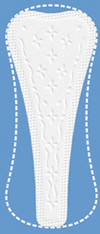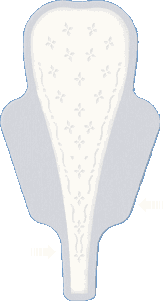

Hi,
Last year my sister found an article in a magazine describing the practice of native Polynesian women using the sea sponge as a tampon for their menstrual protection. Your Web site also offers a very brief section on the "possible" use of these sponges by American troops sent abroad.
I am allergic to most commercial pads and tampons. In my desperation I have already tried the sea sponge as a tampon. I had no side effects but did find that soap and water were not effective enough in washing for odor. This led to a major concern that they were perhaps not clean enough to reuse more than once.
If ANYONE has any data on this product or possible leads I would be most grateful for a quick note and that information.
Thank you,
Dear Harry,
Yes, indeed, soap and water will not effectively clean the sea sponge. The odor emanating from the used and washed sponges represent the action of surviving vaginal bacteria and their degradation of menstrual debris that survives the wash. The only effective way to sanitize those sponges is by boiling for about 5 to 10 minutes. This will kill ALL bacteria there.
Interestingly, looking back in history, women used to boil their menstrual "rags" to get them clean. This is an analogous circumstance.
Best regards,
Phil
 |
 |
Hej, Harry,Yes, this is true, thong
panty-liners were just released this year and are
doing really well. [Pictures at left.] The
company is SCA (the company whose magazine we do here
and that you are appearing in [alongside Astronaut
Sally Ride. See also here.])
|
 |
www.libresse.comwww.bodyform.co.ukwww.libragirl.com.au/You can find a contact at SCA hygiene on their Web site www.sca.se. [Click on the ads on the right side for some television ads, including a funny one for the thong panty pad.]The wooden and plastic boxes for o.b. tampons can be bought at Designtorget stores here in Stockholm on G�tegatan and at Sergel Torg/kulturhuset. [The inventor and maker of the beautiful box, Maria Kreutz, later sent one to this museum - see it.]Regards |
Dear Harry,
Radical Moon Creations has just celebrated it's first year in business. To thank the people who have been a part of our wonderful first year, we're offering you a special promotion:
If you order any of our gift packages in the month of October we'll include a free herbal dream pillow. This very special offer is not advertised in our Web site . . . it's just for you, our clients and friends. Please visit our Web site soon to place your order at http://www.radicalmoon.ca/
Quantities are limited.
Thanks again, from the women at Radical Moon Creations!
Andrea
http://www.radicalmoon.ca/
P.S. Our Web site has some exciting new contributors; visit our new Entrepreneur's Page and our Recipes section to meet them.
A very strange museum, but enjoyable to read. I'm curious as to why you picked the topic of menstruation to base a museum on [read the FAQ and my ideas - not fixed - for the future museum]. We found the lesbian jokes tasteless [so have others], but the costumes made of pads and tampons were hilarious. I hope you keep this site open - it's interesting!
What a great idea! it seems silly that a subject that affects virtually everyone, either because they're female or are friends with/related to a female, is so taboo.
Menstruation, and the attitudes towards it over time, place, and culture, provides an interesting lens through which to see societies and the role of women therein. [You're absolutely right, and it's one reason I am doing this.]
By the way, Ortho/Janssen, makers of a number of contraceptive devices and drugs, has a museum of contraception that is similarly interesting [here's a contraception history]. I don't know if they have a Web site of the museum [here it is], but they do have a booklet that I'm sure is available for the asking.
Congratulations! The editors of the 4anything.com network have chosen your site as one of the best of the Web within your category. We believe that your site provides great value to our 4anything users
Have you been told about a song recorded by Australian singer/songwriter, Robyn Archer, called the Menstruation Blues? It was on an album she put out at least 20 years ago and like a lot of Robyn's work it is very up front. [Yes, I have! The Australian Broadcasting Corporation used it as a background theme for their 16-minute broadcast of a tour of this museum in 1995. The honorary curator of medicine at the Tasmanian Museum was driving to work when he heard the interview and told me almost drove off the road! He later visited MUM.]
The Sydney Morning Herald on Saturday, 2 October 1999 had an article about your Web site. I expect you'll get a lot of hits from Australia because of that.
Great site !!!!!
During the active phase of the war in Korea, 1952, we were a combat engineer battalion in direct support of front-line infantry divisions, on the west edge of "The Punchbowl."
As such we were forbidden to have an officers club, due to our proximity to enemy fire, and to a fluid situation. Naturally, we therefore established one, in a beautiful stone-covered bunker, built for the purpose (with a working fireplace!). We ordered fluids, condiments and accessories appropriate to the Mess/Club of Officers and Gentlemen in the combat zone. The fluids arrived quite soon, but there was a delay for the rest, which didn't seem to matter much . . . until later.
Our supply officer was a teetotaler [he didn't drink alcohol] and rather straight in some ways, so what happened was either by innocence or design. We included several gross of napkins in our accessories requisition, thinking that they'd look right alongside the china and flatware, and set a high tone to things (we anticipated a few "formal" occasions during lulls).
You guessed it! When the truck finally arrived, it was loaded with sanitary napkins (Kotex?), and white ones at that, not olive drab [the usual Army color, designed to disguise people and equipment].
We were forbidden the color white in the combat zone because it was too visible (or maybe might tempt use as a surrender flag? [!!]). Anyway, we didn't dare return the things, as no one upward in the supply chain seemed to have questioned our requisition, and we thought that discretion would be the better part of valor; one doesn't make waves.
There were of course no women at all in any of our units (honestly). [Women have only recently appeared in some combat roles.]
Before long nearly every engineer who had to wear a backpack was sporting white pads discreetly tucked under the shoulder straps, to cushion and to ease the chafing of the load! Some were reported to find their way into boots. Our motor pools found them great oil-and-grease absorbers, and the white color didn't last long, at all. When burned, these even helped warm a few cold hands [Korea was very cold in the winter]. The rest we sent on anonymously to our local MASH [a hospital], which was dangerously close to corps headquarters [their bosses], where unsympathetic, humorless people hung out, who lived to frustrate the front-line units with paperwork, rules and restrictions.
Not long afterwards, our "Officers Mess" ["mess" is Armyese for dining hall] was visited by three of those same corps headquarter types, who explicitly reminded us that officers clubs were forbidden in the combat zone, and that ours was then and there officially shut down, and its stock confiscated.
After sampling the forbidden stock fluids with us for a few hours, they magnanimously elected not to confiscate them after all, but to have them 'equitably' distributed, which was done.
There was an apocryphal anecdote about the Kotex event that followed shortly afterwards. It seems that for a few weeks after our "disposal" of excess stock, our front-line companies [units of a few hundred soldiers] reported that enemy prisoners were showing up with Kotex stuffing in their rubber and canvas shoes, for warmth. Hm . . . .
The inevitable "Army" story was also generated, about how the damned shipment kept arriving at battalion headquarters every month afterwards, and the flow couldn't be stopped. (Pun in there somewhere?)
Everything else, except the last two "stories" was, however, quite true. No Kotex ever found its way into enemy hands (feet?), and there was only the one shipment to the battalion.
if my name were used, there are some who would wonder just why I was into the MUM site in the first place. I'm not totally clear on that one myself, but I saw it listed in Sympatico's "NetLife" monthly magazine as one of several interesting or off-beat sites. Actually, you have built one of the more informative, interesting and significant sites I've visited. Many will appreciate it and profit from it.
Kudos, Harry Finley!! [Thank you, B- Oops, I almost said your name! It's a great story. Actually, I don't put writers' names and addresses with the "letters" unless they ask me to or if it is obvious it's OK, as with a representative of a company.]
Please, may I post a letter on your letter page?
I'm researching a documentary for the BBC [British Broadcasting Corporation] about menstruation - myths and facts and blessing or curse.
I have much information about the curse and prejudice but I am finding scant information about the blessing! I was thrilled to find medical information linking surgery for breast cancer and the menstrual cycle and the New Scientist report about differing medication levels required during the 28-day cycle, and the research about eating requirements differing during the cycle etc., but I want to hear from women who have evidence of the cycle as a blessing, for example, artists, writers, etc., who are at their most creative whilst menstruating.
I also want to meet women who practice menstrual seclusion, as with menstrual huts of the past [and of the present; women still use menstrual huts].
And anything and everything to do with research into menstruation.
Next week I am interviewing Mr Peter Redgrove and Penelope Shuttle who wrote the first book on menstruation that offered positive information, The Wise Wound, 1978. I am very excited about asking many questions resulting from the book. If you have any questions for them pertaining to the book or their second book, Alchemy for Women, about the dream cycle corresponding to the menstrual cycle, I would be delighted to forward them to them on your behalf. They are not on the net so any questions would have to have addresses!
Thank you so much for this glorious Web site [many thanks to you for saying that!] and I look forward to hearing from visitors to your site.
Ali Kedge.
[email protected] or [email protected]
Irregular menses identify women at high risk for polycystic ovary syndrome (PCOS), which exists in 6-10% of women of reproductive age. PCOS is a major cause of infertility and is linked to diabetes.